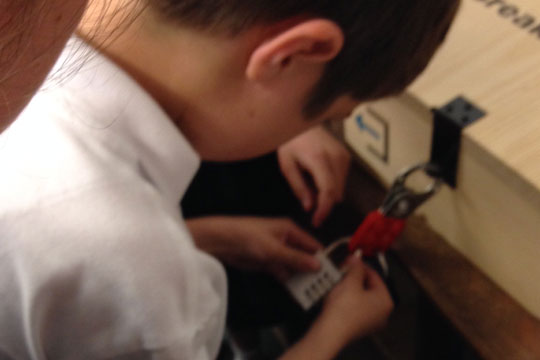
I love seeing my students after our Easter break. They look fresh-faced with that “I-just-got-a-haircut” look, they seem taller, and they are sporting a new pair of shoes! I greet them with with colorful Easter decorations, which include my table-top sized Easter tree.
Each Easter I love teaching my students about the Orthodox paschal greeting. You say, “Christ is Risen!” Your neighbor replies, “Indeed he is Risen!” What a great way to greet your neighbors during the Easter season. We practice this on our first day back from Easter break. Anyone who enters our room is greeted this way.
A few years ago, I came upon a Web site where this paschal greeting is written and spoken in 250 different languages. This added a new dimension to this greeting and showed the universality of our faith to my students.
Knowing that my students would want to explore this site, I came up with an activity using QR codes. A QR code is a type of bar code that you can scan using a smart phone. The students would scan the QR code, listen to the greeting, and then guess which language it was.
My students are familiar with using a QR code reader. Our school uses the i-nigma reader, which is easy to set up. All I needed to do was generate a QR code image for the songs. This, I soon realized, was easier said than done.

I’ve created QR codes in the past using the Google Chrome extension called goo.gl URL Shortener. However, I didn’t realize that Chrome could not play the audio files with the paschal greetings, which were formatted as WAV files. I hopped on to Twitter and asked a few questions for another way to create my QR codes. I got several answers and suggestions from my Twitter friends. But it was my oldest son who knew exactly how to help. By using Firefox, Audacity, Dropbox, and a QR code generator, I followed the steps below to create my QR code activity:
- First, I went to the Web site and selected the language I wanted to use. I saved the audio file by clicking File, and then I selected Save Page As.
- I opened the file in Audacity.
- I exported the audio file as an MP3 file.
- I uploaded the file into my public file in Dropbox, and I then copied the public link.
- I used that link to make a QR code in a QR code generator.
- I copied the QR code and pasted it into a drawing program.
- Using the drawing program, I printed out the QR codes and placed them outside our classroom door.
- Students used a QR code reader to listen to the greetings.
- Students checked which languages they believed the greeting was spoken in.
The best part of this activity was not giving up on my desire to do this cool activity for my students, in spite of all the challenges. I asked a lot of questions and learned a new way to accomplish my goal. I needed a lot of patience, persistence, help, and humility to pull this activity off.
When you are thinking of celebrating Easter this year with your students, try something new to celebrate the Resurrection of Jesus Christ. Try taking an old activity (for example, learning paschal greetings) and do it in a new way (for example, using QR codes) to celebrate the glory of Easter!





Barb, thanks for sharing your idea and the steps for creating a QR code. I love the idea of the Easter greeting in different languages. I got a laugh when I posted the Greek Easter greeting on my Facebook page – Christos Anesti – knowing that some folks would respond with Alithos Anesti – “He is risen indeed.” The first person who attempted to do so, however, was the victim of spellcheck which changed Alithos to Alison, so apparently Alison is risen too!
Thanks, Joe! It was so nice visiting with you at the Catholic teacher convention in Orlando.
To my fellow teachers, it’s not too late to give this activity a try. It’s still the Easter season!